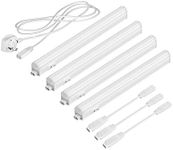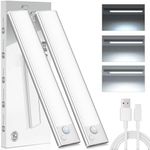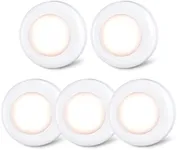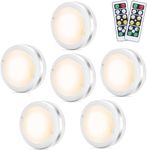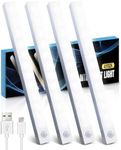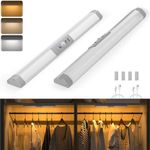Buying Guide for the Best Under Cabinet Lights
Under-cabinet lights are a fantastic way to enhance the functionality and aesthetics of your kitchen or workspace. They provide focused illumination on countertops, making tasks like cooking and reading recipes easier, while also adding a warm ambiance to the room. When choosing under-cabinet lights, consider the type of lighting, installation method, and energy efficiency to ensure you select the best option for your needs.Type of LightThe type of light refers to the kind of bulb or lighting technology used in the under-cabinet lights. Common types include LED, fluorescent, and halogen. LED lights are popular due to their energy efficiency, long lifespan, and low heat emission. Fluorescent lights are also energy-efficient but may not offer the same warmth as LEDs. Halogen lights provide bright, focused light but can get hot and consume more energy. Consider LED lights if you want a long-lasting, energy-efficient option with a variety of color temperatures.
BrightnessBrightness is measured in lumens and determines how much light the fixture emits. For task lighting, you might want brighter lights, typically around 200-500 lumens per foot, to ensure you can see clearly while working. For ambient lighting, lower lumens might suffice. Consider your primary use for the lights: if you need them for detailed tasks, opt for higher lumens; for mood lighting, lower lumens may be adequate.
Color TemperatureColor temperature is measured in Kelvin (K) and describes the color of the light emitted. Lower Kelvin numbers (2700K-3000K) produce a warm, yellowish light, while higher numbers (4000K-5000K) emit a cooler, bluish light. Warm light is often preferred for creating a cozy atmosphere, while cool light is better for task-oriented areas where clarity is important. Choose a color temperature that matches the mood you want to create and the tasks you will perform.
Installation MethodInstallation method refers to how the lights are mounted and powered. Options include plug-in, battery-operated, and hardwired. Plug-in lights are easy to install and move but require an outlet. Battery-operated lights offer flexibility and are ideal for areas without electrical access but require regular battery changes. Hardwired lights are more permanent and eliminate visible cords but require professional installation. Consider your DIY skills and the permanence of the installation when choosing.
Dimming CapabilityDimming capability allows you to adjust the brightness of the lights to suit different needs and moods. Some under-cabinet lights come with built-in dimmers or are compatible with external dimmer switches. This feature is useful if you want to switch between bright task lighting and softer ambient lighting. If versatility in lighting levels is important to you, look for lights with dimming capabilities.
Energy EfficiencyEnergy efficiency refers to how much electricity the lights use relative to the amount of light they produce. LED lights are typically the most energy-efficient, using less power and lasting longer than other types. Energy-efficient lights can save you money on electricity bills and reduce your environmental footprint. If sustainability and cost savings are priorities, opt for energy-efficient lighting options.



